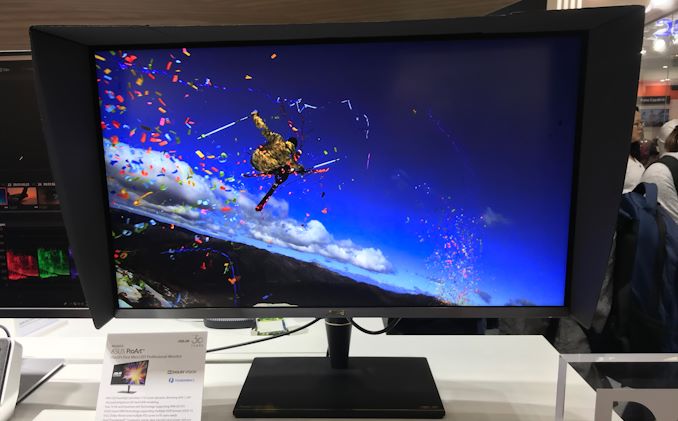ASUS Mini LED Professional Monitors Update: Available This Year
by Anton Shilov on June 14, 2019 8:00 AM EST- Posted in
- Monitors
- Displays
- Asus
- Trade Shows
- 4K
- ProArt
- Mini LED
- Computex 2019

Earlier this year ASUS announced two ProArt displays featuring Mini LED-based backlighting supporting full array local dimming (FALD) aimed at professionals. The ProArt PA32UCX with 1152-zone FALD was introduced at CES, whereas the smaller ProArt PA27UCX with 576-zone FALD was quietly unveiled later on. At Computex, the company provided an update regarding their availability.
The large 32-inch ProArt PA32UCX display with a 1152-zone FALD is nearly ready and will be available sometimes in late June, according to an ASUS representative at the company’s booth. The smaller 27-inch ProArt PA27UCX monitor with a 576-zone FALD is several months behind the flagship, so it is still being polished off. The same rep assured that this LCD will still be available by the end of the year, but refused to reveal any more precise information.
While the ProArt PA32UCX and the ProArt PA27UCX displays are different when it comes to diagonal sizes and the number of FALD zones, they have a lot in common. Both are based on 10-bit IPS panels featuring a 3840×2160 resolution, 1,000 – 1,200 nits peak brightness, a high contrast ratio, and a 60 Hz refresh rate. The monitors are factory calibrated to ΔE < 2 accuracy, they cover 99% of DCI-P3, 89% of Rec. 2020, 99.5% of Adobe RGB, and 100% of sRGB color spaces used for video post-production as well as graphics design nowadays.
Besides, both Mini LED-enabled monitors from ASUS support numerous HDR formats, including HDR10, hybrid log gamma (HLG), and Dolby Vision (the 32-incher only, so far). The two LCDs also meet or exceed requirements for VESA’s DisplayHDR 1000 logo. Last but not least, both displays feature either Thunderbolt 3 or USB Type-C connectivity with 60 W Power Delivery.
| Specifications of the ASUS ProArt Mini LED Displays | |||
| ProArt PA27UCX | ProArt PA32UCX | ||
| Panel | 27" IPS | 32" IPS | |
| Native Resolution | 3840 × 2160 | ||
| Maximum Refresh Rate | 60 Hz | ||
| Response Time | unknown | unknown | |
| Brightness | 1000 cd/m² (peak) | 1200 cd/m² (peak) | |
| Contrast | high | high | |
| Viewing Angles | 178°/178° horizontal/vertical | ||
| HDR | HDR10, HLG | HDR10, HLG, Dolby Vision | |
| Backlighting | Mini-LED-based 576-zone FALD |
Mini-LED-based 1152-zone FALD |
|
| Pixel Pitch | 0.1845 mm² | ||
| Pixel Density | 138 ppi | ||
| Display Colors | 1.07 billion | ||
| Color Gamut Support | DCI-P3: 99% Adobe RGB: 99.5% Rec. 2020: 89% sRGB: 100% |
||
| Aspect Ratio | 16:9 | ||
| Stand | Hight, Tilt, and Swivel adjustable | ||
| Inputs | 1 × DisplayPort 1 × USB-C 1 × HDMI 2.0 |
1 × DisplayPort 2 × Thunderbolt 3 (in/out) 1 × HDMI 2.0 |
|
| USB Hub | USB hub | ||
| Launch Date | Late 2019 | June 2019 | |
Pricing of the ProArt PA32UCX and the ProArt PA27UCX is something that remains to be seen. Evidently, Mini LED-based backlighting is a new technology and costs more than traditional units. Furthermore, both monitors belong to professional pedigree, so expect them to be priced accordingly.
Related Reading:
- ASUS at CES 2019: ProArt PA32UCX 4K Monitor with 1000-Zone FALD Unveiled
- ASUS Shows Off Dolby Vision Monitors: The ProArt PQ22UC & ProArt PA32UCX
| Want to keep up to date with all of our Computex 2019 Coverage? | ||||||
 Laptops |
 Hardware |
 Chips |
||||
| Follow AnandTech's breaking news here! | ||||||














24 Comments
View All Comments
Alistair - Friday, June 14, 2019 - link
Yeah I'm expecting $4000+ at least for the inferior 32 inch monitor vs the Apple one. Apple's new monitor won't be beaten. I was more mad about the Mac Pro than the monitor.zodiacfml - Saturday, June 15, 2019 - link
Interesting, same thoughts while reading it. I think it was Hisense which has a demo TV last CES. On paper, seems cheapest tech for achieving close to OLED contrast though MicroLED can take on brighter environments with ease.sitti - Saturday, June 15, 2019 - link
The price of previous model PC32UC was $1999, and a new one won't cost $4000+. Acer already announced similar (or practically the same) spec monitor ConceptD CM7321K and it's price is $2999. Asus should be the same price, just like 27" FALD gaming monitors. I'm getting Asus monitor as soon as it's released. So far Acer still hasn't mentioned at all about Dolby Vision on their new monitor. Maybe it doesn't support it.alicetaylor - Thursday, June 20, 2019 - link
The ProArt PA32UCX has a distinctive design of ProArt lines with lines ... The viewing angle of the screen is very wide, 178 degrees from the sides. ... to 384 direct-LED light areas to support HDR with ASUS LED Driving technology.http://theimpossiblequiz.xyz